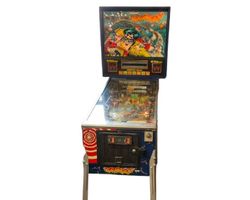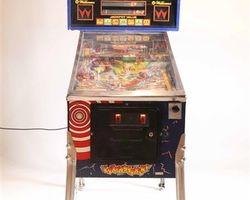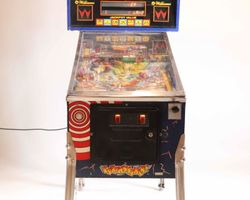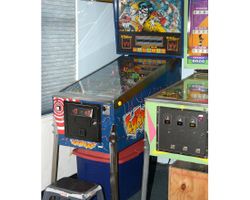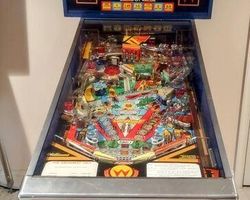Earthshaker
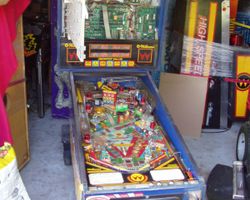
Average Prices: USD $500 to $2,200
Produced: Febuary, 1989
Production Run: 5,257 units
Machine Type: Solid State Electronic
MPU: Williams System 11B
Players: 4
Concept by: Pat Lawlor
Design by: Pat Lawlor
Art by: Tim Elliot, Tim Elliott
Mechanics by: John Krutsch
Music by: Chris Granner, Jon Hey
Sound by: Chris Granner
Software by: Mark Penacho
"Earthshaker" emerged from Williams Electronic Games in February 1989, an innovative Solid State Electronic (SS) pinball machine running on the robust Williams System 11B platform. Its core concept, conceived by designer Pat Lawlor, revolved around the dramatic theme of an earthquake, a natural disaster translated into a kinetic, interactive experience. The game was brought to life by a team of skilled contributors: Tim Elliot crafted the distinctive artwork, Chris Granner composed the music and sound design, Mark Penacho developed the software, and Mark Ritchie provided custom callouts alongside Soumya Netrabile. This collaborative effort aimed to deliver a pinball experience that was both thematically cohesive and mechanically groundbreaking.
With a production run of 5,257 units, "Earthshaker" quickly made its mark. It shipped throughout 1989, with the first units leaving the factory on February 28th. A particularly intriguing detail from its production history involves the "Earthshaker Institute" building, a prominent feature on the playfield. Early sample games, estimated to be around 200 units, featured a motor assembly that allowed this building to sink into the playfield, visually simulating an earthquake's destruction. This ambitious mechanical element was later omitted in mass production due to cost considerations, making these initial units distinct collectibles. Another notable innovation embedded in "Earthshaker" was the introduction of a "family" game ROM, offering an alternative set of callouts to remove a phrase considered potentially offensive at the time, demonstrating Williams's early consideration for broader audience appeal.
Signature Features and Design
"Earthshaker" stands out primarily for one revolutionary feature: the shaker motor. This mechanism, a first in pinball history, vibrates the entire machine at key moments during gameplay, directly immersing the player in the sensation of an earthquake. When combined with dramatic sound effects and visual cues, the shaker motor transforms a standard pinball experience into a physically resonant one, enhancing the theme's excitement and impact. This innovation profoundly influenced future pinball machine design across the industry, becoming a common element in many subsequent titles from various manufacturers.
Beyond the shaker motor, the machine features a unique diverter on the California/Nevada ramp. This mechanism opens a pathway between the two states, symbolizing a fault line separating during seismic activity. This not only adds a thematic layer to the shots but also provides a dynamic change to the ball's trajectory, keeping players engaged. The "Earthshaker Institute" building, despite its simplified stationary form in most production units, serves as a central visual element on the playfield, its nine lights tracking player progress through different "zones." The custom speech, including the memorable "Bitchin'!" callout in standard ROMs, further reinforces the game's energetic and slightly rebellious character, contributing to its overall captivating design.
Playfield and Mechanics
The "Earthshaker" playfield layout is designed for flow and direct interaction, reflecting Pat Lawlor's early design principles. It features three flippers, providing varied shot angles and control. At the top of the playfield, three pop bumpers are positioned to create a lively and unpredictable rebound zone, often sending the ball towards crucial targets. Two vertical upkickers provide swift ball returns, adding to the game's pace. A three-bank of drop targets must be cleared to access specific objectives, while a kick-out hole and a spinning target offer scoring opportunities and ball manipulation. A single captive ball contributes to shot variety and strategy.
The two prominent ramps, representing California and Nevada, are central to the playfield's design philosophy. The left ramp leads to the "California" shot, while the right leads to "Nevada." The game encourages players to shoot these ramps repeatedly, particularly the center ramp which often serves as a key shot for progression. The diverter on the California/Nevada ramp visually and mechanically splits the playfield, creating a sense of the ground breaking apart. The artwork by Tim Elliot reinforces the earthquake theme with detailed depictions of cracked roads, collapsing buildings, and seismograph readings, all rendered in a vibrant, slightly cartoonish style. The lighting scheme, particularly around the "Earthshaker Institute" and key targets, illuminates as players achieve objectives, providing clear feedback and enhancing the visual narrative of seismic activity. The overall aesthetic is one of chaotic energy, where every shot feels like it could trigger the next tremor.
Gameplay Dynamics
"Earthshaker" employs a straightforward yet engaging gameplay progression centered on triggering various earthquake events. The primary objective is to light up the nine zones on the "Earthshaker Institute" building by hitting specific targets and ramps. As zones are lit, the intensity of the simulated earthquake increases, culminating in major tremor events and multiball. The scoring system rewards accuracy and consistency, with repeated ramp shots and target hits contributing significantly to the player's score.
The game's progression is largely tied to achieving multiball, which is initiated by locking three balls in various locations, often through successful ramp shots. Once multiball is activated, the game intensifies with higher scoring opportunities and increased shaker motor activity, transforming the playfield into a pulsating, vibrating chaos. Players strategize to maintain multiple balls in play, aiming for high-value shots while the machine physically shakes. The callouts, especially the "Bitchin'!" sound bite, punctuate successful plays and high-scoring moments, adding to the game's character. While the rules may appear simpler compared to later, more complex pinball machines, "Earthshaker" excels in its directness, focusing on accessible shot-making and the immediate gratification of its signature physical effects. This design ensures that both novice players can quickly grasp the core objectives, while experienced players can refine their shot accuracy and multiball strategies for higher scores.
Reception and Legacy
Upon its release, "Earthshaker" garnered a largely positive reception within the pinball community, solidifying its place as a memorable title from the System 11 era. Its primary strength, universally praised, was the groundbreaking shaker motor, which offered a novel, immersive experience that perfectly complemented the earthquake theme. Players appreciated how this physical feedback heightened the game's excitement and thematic integration. The vibrant artwork and sound package were also well-regarded for capturing the disaster theme with an energetic and fun aesthetic. The game's playfield layout, characterized by its accessible ramps and straightforward shot opportunities, contributed to its reputation as an approachable yet engaging title with good flow. The excitement of its multiball modes further enhanced its appeal and replay value.
However, "Earthshaker" also faced some critiques. A common point of feedback centered on the potential for repetitive gameplay, particularly due to the emphasis on shooting the center ramp, which some players found could be exploited for high scores. This sometimes led to a perception that the rules lacked the depth and complexity found in subsequent pinball machines. While the art style was generally liked, a small segment of players found it less appealing. Some also noted that the cabinet design, while functional, could have been more visually distinctive to match the dynamic playfield. Despite these points, "Earthshaker"'s legacy is firmly established. It is remembered as the first machine to incorporate a shaker motor, pioneering a feature that became a staple in pinball design. It holds a significant position as an early example of Pat Lawlor's distinctive design philosophy, laying groundwork for his later, equally influential games like "Whirlwind" and "Funhouse." Its direct appeal, physical interaction, and innovative spirit continue to resonate with enthusiasts, securing its status as a classic from Williams's productive System 11 period.
Sponsored Links
 Ebay Listings
Ebay Listings
 Auction Results
Auction Results
| Cost | Location | Date |
|---|---|---|
| USD $3,400 |  Pennsylvania, United States Pennsylvania, United States |
04 April, 2025 |
| USD $3,500 |  Georgia, United States Georgia, United States |
23 September, 2024 |
| USD $2,800 |  Wisconsin, United States Wisconsin, United States |
14 September, 2024 |
| USD $2,300 |  United States United States |
28 June, 2024 |
| USD $3,889 |  Florida, United States Florida, United States |
26 June, 2024 |
| USD $2,600 |  Ohio, United States Ohio, United States |
07 January, 2024 |
| USD $1,825 |  Indiana, United States Indiana, United States |
31 December, 2023 |
| USD $2,500 |  Pennsylvania, United States Pennsylvania, United States |
17 December, 2023 |
| USD $4,395 |  Colorado, United States Colorado, United States |
15 December, 2023 |
| USD $1,700 |  New York, United States New York, United States |
23 October, 2023 |


Private Policy · Search Website · Contact Us
As an eBay Partner, we may earn a commission from qualifying purchases made through links on this site, at no additional cost to you.
All trademarks and copyrighted materials remain property of their respective owners. All other content copyright 2007 - 2025 Pinpedia.

